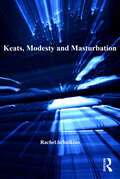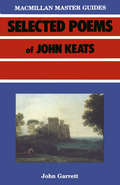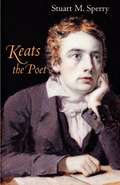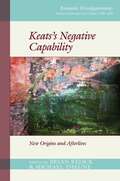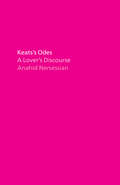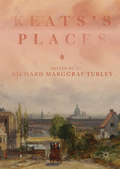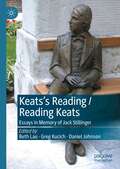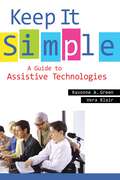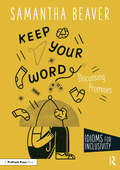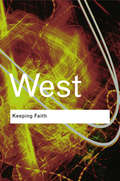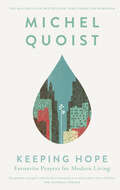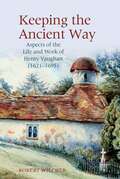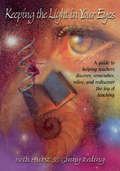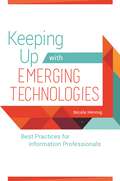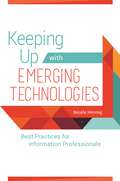- Table View
- List View
Keats, Modesty and Masturbation
by Rachel SchulkinsExamining John Keats’s reworking of the romance genre, Rachel Schulkins argues that he is responding to and critiquing the ideals of feminine modesty and asexual femininity advocated in the early nineteenth century. Through close readings of Isabella; or the Pot of Basil, The Eve of St. Agnes, Lamia and ’La Belle Dame sans Merci,’ Schulkins offers a re-evaluation of Keats and his poetry designed to demonstrate that Keats’s sexual imagery counters conservative morality by encoding taboo desires and the pleasures of masturbation. In so doing, Keats presents a version of female sexuality that undermines the conventional notion of the asexual female. Schulkins engages with feminist criticism that largely views Keats as a misogynist poet who is threatened by the female’s overwhelming sexual and creative presence. Such criticism, Schulkins shows, tends towards a problematic identification between poet and protagonist, with the text seen as a direct rendering of authorial ideology. Such an interpretation neither distinguishes between author, protagonist, text, social norms and cultural history nor recognises the socio-sexual and political undertones embedded in Keats’s rendering of the female. Ultimately, Schulkins’s book reveals how Keats’s sexual politics and his refutation of the asexual female model fed the design, plot and vocabulary of his romances.
Keats the Poet
by Stuart M. SperryKeats the Poet was first published in 1973, just as the crest of all the New-Critical exegeses had passed, leaving the critical literature with a wealth of fine readings, but without a real organizing program within which to view them. Stuart Sperry established such a frame of reference. Further, he did so with such prescience that even the most radical deconstructive or new historical approaches to Keats today must bear witness to their inception in Sperry's emphasis on, and subtle demonstration of, the centrality of "indeterminacy' in the poet. Now available in paperback for the first time, this work will enlighten a new generation of readers.
Keats’s Negative Capability: New Origins and Afterlives (Romantic Reconfigurations: Studies in Literature and Culture 1780-1850 #6)
In late December 1817, when attempting to name “what quality went to form a Man of Achievement especially in Literature,” John Keats coined the term “negative capability,” which he glossed as “being in uncertainties, Mysteries, doubts, without any irritable reaching after fact & reason.” Since then negative capability has continued to shape assessments of and responses to Keats’s work, while also surfacing in other contexts ranging from contemporary poetry to punk rock. The essays collected in this volume, taken as a whole, account for some of the history of negative capability, and propose new models and directions for its future in scholarly and popular discourse. The book does not propose a particular understanding of negative capability from among the many options (radical empathy, annihilation of self, philosophical skepticism, celebration of ambiguity) as the final word on the topic; rather, the book accounts for the multidimensionality of negative capability. Essays treat negative capability’s relation to topics including the Christmas pantomime, psychoanalysis, Zen Buddhism, nineteenth-century medicine, and Philip Pullman’s His Dark Materials trilogy. Describing the “poetical Character” Keats notes that “it enjoys light and shade; it lives in gusto, be it foul or fair, high or low, rich or poor, mean or elevated.” This book, too, revels in such multiplicity.
Keats's Odes: A Lover's Discourse
by Anahid Nersessian“When I say this book is a love story, I mean it is about things that cannot be gotten over—like this world, and some of the people in it.” In 1819, the poet John Keats wrote six poems that would become known as the Great Odes. Some of them—“Ode to a Nightingale,” “To Autumn”—are among the most celebrated poems in the English language. Anahid Nersessian here collects and elucidates each of the odes and offers a meditative, personal essay in response to each, revealing why these poems still have so much to say to us, especially in a time of ongoing political crisis. Her Keats is an unflinching antagonist of modern life—of capitalism, of the British Empire, of the destruction of the planet—as well as a passionate idealist for whom every poem is a love poem. The book emerges from Nersessian’s lifelong attachment to Keats’s poetry; but more, it “is a love story: between me and Keats, and not just Keats.” Drawing on experiences from her own life, Nersessian celebrates Keats even as she grieves him and counts her own losses—and Nersessian, like Keats, has a passionate awareness of the reality of human suffering, but also a willingness to explore the possibility that the world, at least, could still be saved. Intimate and speculative, this brilliant mix of the poetic and the personal will find its home among the numerous fans of Keats’s enduring work.
Keats's Places
by Richard Marggraf TurleyAs the essays in this volume reveal, Keats’s places could be comforting, familiar, grounding sites, but they were also shifting, uncanny, paradoxical spaces where the geographical comes into tension with the familial, the touristic with the medical, the metropolitan with the archipelagic. Collectively, the chapters in Keats’s Places range from the claustrophobic stands of Guy’s Hospital operating theatre to the boneshaking interior of the Southampton mail coach; from Highland crags to Hampstead Heath; from crowded city interiors to leafy suburban lanes. Offering new insights into the complex registrations of place and the poetic imagination, the contributors to this book explore how the significant places in John Keats’s life helped to shape an authorial identity.
Keats's Places
by Richard Marggraf TurleyAs the essays in this volume reveal, Keats’s places could be comforting, familiar, grounding sites, but they were also shifting, uncanny, paradoxical spaces where the geographical comes into tension with the familial, the touristic with the medical, the metropolitan with the archipelagic. Collectively, the chapters in Keats’s Places range from the claustrophobic stands of Guy’s Hospital operating theatre to the boneshaking interior of the Southampton mail coach; from Highland crags to Hampstead Heath; from crowded city interiors to leafy suburban lanes. Offering new insights into the complex registrations of place and the poetic imagination, the contributors to this book explore how the significant places in John Keats’s life helped to shape an authorial identity.
Keats’s Reading / Reading Keats: Essays in Memory of Jack Stillinger
by Daniel Johnson Beth Lau Greg KucichThis book explores John Keats’s reading practices and intertextual dialogues with other writers. It also examines later writers’ engagements with Keats’s poetry. Finally, the book honors the distinguished Keats scholar Jack Stillinger and includes an essay surveying his career as well as a bibliography of his major publications. The first section of the volume, “Theorizing Keats’s Reading,” contains four essays that identify major patterns in the poet’s reading habits and responses to other works. The next section, “Keats’s Reading,” consists of six essays that examine Keats’s work in relation to specific earlier authors and texts. The four essays in the third section, “Reading Keats,” consider how Keats’s poetry influenced the work of later writers and became embedded in British and American literary traditions. The final section of the book, “Contemporary Poetic Responses,” features three scholar-poets who, in poetry and/or prose commentary, discuss and exemplify Keats’s impact on their work.
Keep It Simple: A Guide to Assistive Technologies
by Ravonne A. Green Vera BlairSimple, straightforward guidance for the practitioner who wants to use assistive technologies to extend library access.Keep it Simple: A Guide to Assistive Technologies provides a basic tutorial on common assistive computer applications and commonly available, inexpensive hardware and software to help librarians incorporate such aids into the library's current infrastructure.Focusing on applications commonly available on Microsoft Office and other low-cost technologies, this book offers guidance for the practitioner that can help every library move toward universal access. Librarians will find advice on planning accessible services, selecting appropriate assistive technologies, marketing disability services and assistive technology, and training staff in disability services issues and the use of assistive technology. Individual chapters cover print, hearing, speech, and mobility disabilities, offering resources and tutorials for each of these disability categories.
Keep the Aspidistra Flying (Oxford World's Classics)
by George Orwell"Money is what God used to be. Good and evil have no meaning any longer except failure and success." Disgusted by society's materialism, Gordon Comstock leaves his job in advertising to pursue an ill-fated career as a poet. In his race to the bottom, only Rosemary, his long-suffering girlfriend, challenges Gordon's self-destructive course. The novel contains the most sustained reflections on the role of the author and the artistic imagination anywhere in Orwell's fiction, as the book's protagonist struggles (and ultimately fails) to reconcile his romantic-aestheticist sensibilities with the pressures of the literary marketplace and with social expectations. Completed while Orwell travelled north to work on The Road to Wigan Pier, this novel is a key transitional text in his career. Offering a powerful portrayal of the emotional toll of precarity and the desire to break with capitalism, Keep the Aspidistra Flying is a significant work of mid-century British fiction but it also speaks to our own time. ABOUT THE SERIES: For over 100 years Oxford World's Classics has made available the widest range of literature from around the globe. Each affordable volume reflects Oxford's commitment to scholarship, providing the most accurate text plus a wealth of other valuable features, including expert introductions by leading authorities, helpful notes to clarify the text, up-to-date bibliographies for further study, and much more.
Keep the Aspidistra Flying (Oxford World's Classics)
by George Orwell"Money is what God used to be. Good and evil have no meaning any longer except failure and success." Disgusted by society's materialism, Gordon Comstock leaves his job in advertising to pursue an ill-fated career as a poet. In his race to the bottom, only Rosemary, his long-suffering girlfriend, challenges Gordon's self-destructive course. The novel contains the most sustained reflections on the role of the author and the artistic imagination anywhere in Orwell's fiction, as the book's protagonist struggles (and ultimately fails) to reconcile his romantic-aestheticist sensibilities with the pressures of the literary marketplace and with social expectations. Completed while Orwell travelled north to work on The Road to Wigan Pier, this novel is a key transitional text in his career. Offering a powerful portrayal of the emotional toll of precarity and the desire to break with capitalism, Keep the Aspidistra Flying is a significant work of mid-century British fiction but it also speaks to our own time. ABOUT THE SERIES: For over 100 years Oxford World's Classics has made available the widest range of literature from around the globe. Each affordable volume reflects Oxford's commitment to scholarship, providing the most accurate text plus a wealth of other valuable features, including expert introductions by leading authorities, helpful notes to clarify the text, up-to-date bibliographies for further study, and much more.
Keep Your Word: Discussing Promises (Idioms for Inclusivity)
by Samantha BeaverTo get the complete Idioms for Inclusivity experience, this book can be purchased alongside four others as a set, Idioms for Inclusivity: Fostering Belonging with Language, 978-1-032-28635-8. Informed by sociolinguistic research, yet written accessibly, Keep Your Word challenges readers to investigate the act of promising as it relates to both language-use and inclusivity. This engaging and delightfully illustrated book invites students to engage with concepts such as: the cultural meaning of the idiom "keep your word", Speech Acts and Felicity Conditions, two frameworks that linguists use to research and understand promises, why the expectation to "keep your word" can make someone feel excluded, and how understanding the way language works can help learn to be more inclusive. Featuring practical inclusivity tips related to promises, this enriching curriculum supplement can be used in a Language Arts setting to learn about figurative language; in a Social Studies setting to discuss diversity, equity, inclusion, and belonging; or as an introduction to linguistics for students ages 7-14.
Keep Your Word: Discussing Promises (Idioms for Inclusivity)
by Samantha BeaverTo get the complete Idioms for Inclusivity experience, this book can be purchased alongside four others as a set, Idioms for Inclusivity: Fostering Belonging with Language, 978-1-032-28635-8. Informed by sociolinguistic research, yet written accessibly, Keep Your Word challenges readers to investigate the act of promising as it relates to both language-use and inclusivity. This engaging and delightfully illustrated book invites students to engage with concepts such as: the cultural meaning of the idiom "keep your word", Speech Acts and Felicity Conditions, two frameworks that linguists use to research and understand promises, why the expectation to "keep your word" can make someone feel excluded, and how understanding the way language works can help learn to be more inclusive. Featuring practical inclusivity tips related to promises, this enriching curriculum supplement can be used in a Language Arts setting to learn about figurative language; in a Social Studies setting to discuss diversity, equity, inclusion, and belonging; or as an introduction to linguistics for students ages 7-14.
Keepers of the Flame: Literary Estates and the Rise of Biography
by Ian HamiltonLiterary biography is an endlessly fascinating form, not least because of the fierce controversies that attend the question of how much of a writer's real life ought to be related to readers. Ian Hamilton, a first-rate biographer who encountering his share of adversity in writing the life of J.D. Salinger, is the perfect chronicler of such controversies in this brilliant study, first published in 1992, which charts the course of literary biography from Donne and Shakespeare to Plath and Larkin.'Such a compelling read.' Antonia Fraser, Times'Lively and informative, powerfully and humorously written.' Anthony Burgess, Observer'Surely the funniest book ever written on the doom-laden issue of posthumous literary fame.' Jonathan Keates, Independent
Keeping Faith: Philosophy and Race in America
by Cornel West'The sheer range of West's interests and insights is staggering and exemplary: he appears equally comfortable talking about literature, ethics, art, jurisprudence, religion, and popular-cultural forms.' - Artforum Keeping Faith is a rich, moving and deeply personal collection of essays from one of the leading African American intellectuals of our age. Drawing upon the traditions of Western philosophy and modernity, Cornel West critiques structures of power and oppression as they operate within American society and provides a way of thinking about human dignity and difference afresh. Impressive in its scope, West confidently and deftly explores the politics and philosophy of America, the role of the black intellectual, legal theory and the future of liberal thought, and the fate of African Americans. A celebration of the extraordinary lives of ordinary Americans, Keeping Faith is a petition to hope and a call to faith in the redemptive power of the human spirit.
Keeping Faith: Philosophy and Race in America
by Cornel West'The sheer range of West's interests and insights is staggering and exemplary: he appears equally comfortable talking about literature, ethics, art, jurisprudence, religion, and popular-cultural forms.' - Artforum Keeping Faith is a rich, moving and deeply personal collection of essays from one of the leading African American intellectuals of our age. Drawing upon the traditions of Western philosophy and modernity, Cornel West critiques structures of power and oppression as they operate within American society and provides a way of thinking about human dignity and difference afresh. Impressive in its scope, West confidently and deftly explores the politics and philosophy of America, the role of the black intellectual, legal theory and the future of liberal thought, and the fate of African Americans. A celebration of the extraordinary lives of ordinary Americans, Keeping Faith is a petition to hope and a call to faith in the redemptive power of the human spirit.
Keeping Hope – Favourite Prayers for Modern Living: Selected Inspirational Prayers from World-Renowned Theologian Michel Quoist
by Michel QuoistPrayers from Michel Quoist, the multi-million bestselling publishing phenomenon, available for the first time as an ebookThe prayers of Michel Quoist are not prayers in the usual sense, but meditations on life. Beginning with seemingly ordinary events, suddenly the light of faith is thrown on some part of our ordinary, everyday existence. Set against the roads, offices and high-rise buildings that frame our modern world, this collection of practical prayers and meditations penetrates the heart of human experience.Rooted in the modern world and in the thoughts and feelings that define our everyday experience, they celebrate our small victories and offer support as we struggle with universal themes – among them self-acceptance, loneliness, despair, ageing, loss and grief. Quoist’s prayers encourage us to celebrate and harness the tools and talents we have at our disposal to make the best of what we have. Editorial Reviews'His greatest strength is that he shows humanity as an asset rather than a liability.' The Catholic Herald'To those long familiar with Quoist’s writing – and those who are new to him – this book may prove a landmark in the spiritual lives of many in a new century and a new millennium.' Peter Costello, The Irish Catholic'Michel Quoist sold millions of books in 27 different languages because of that ability to make prayer possible for the less contemplative among us.' Fr Brian D' Arcy, Sunday World
Keeping the Ancient Way: Aspects of the Life and Work of Henry Vaughan (1621-1695) (English Association Monographs: English at the Interface #7)
by Robert WilcherWritten by one of the editors of the new complete works of Henry Vaughan, Keeping the Ancient Way is the first book-length study of the poet by a single author for twenty years. It deals with a number of key topics that are central to the understanding and appreciation of this major seventeenth-century writer. These include his debt to the hermetic philosophy espoused by his twin brother (the alchemist, Thomas Vaughan); his royalist allegiance in the Civil War; his loyalty to the outlawed Church of England during the Interregnum; the unusual degree of intertextuality in his poetry (especially with the Scriptures and the devotional lyrics of George Herbert); and his literary treatment of the natural world (which has been variously interpreted from Christian, proto-Romantic, and ecological perspectives). Each of the chapters is self-contained and places its topic in relation to past and current critical debates, but the book is organized so that the biographical, intellectual, and political focus of Part One informs the discussion of poetic craftsmanship in Part Two. A wealth of historical information and close critical readings provide an accessible introduction to the poet and his period for students and general readers alike. The up-to-date scholarship will also be of interest to specialists in the literature and history of the Civil War and Interregnum.
Keeping the Light in Your Eyes: A Guide to Helping Teachers Discover, Remember, Relive, and Rediscover the Joy of Teaching
by Beth Hurst Ginny RedingThe authors of this inspirational new book were on a mission. While much has been written about teacher burnout and the day-to-day problems teachers face, little has been written about how teachers who deal with these problems overcome them, and continue to enter the classroom each morning with enthusiasm for their calling. To discover such teachers, the authors interviewed over 70 teachers in communities across the country to find teachers who, in a profession characterized by pressure, stress, and little reward, still find teaching an enjoyable, fulfilling career. The book includes over 150 teacher narratives of their real-life classroom experiences. The narratives provide unique insights into creating a teaching mission, setting up a community of learners, discovering the rewards of diversity, balancing personal and professional time, turning mistakes into excellence, using laughter to create rapport with students, and using discipline to create an atmosphere of trust and cooperation in the classroom. From these inspirational stories emerges a vision of the joys and rewards of working with children and a portrait of the teachers who have made a difference in the lives of their students and a contribution to their community. The quotes, stories, and advice written in the teachers' own words are interwoven with practical suggestions for ideas to make the classroom an inspirational environment for students and teachers alike.
Keeping the Light in Your Eyes: A Guide to Helping Teachers Discover, Remember, Relive, and Rediscover the Joy of Teaching
by Beth Hurst Ginny RedingThe authors of this inspirational new book were on a mission. While much has been written about teacher burnout and the day-to-day problems teachers face, little has been written about how teachers who deal with these problems overcome them, and continue to enter the classroom each morning with enthusiasm for their calling. To discover such teachers, the authors interviewed over 70 teachers in communities across the country to find teachers who, in a profession characterized by pressure, stress, and little reward, still find teaching an enjoyable, fulfilling career. The book includes over 150 teacher narratives of their real-life classroom experiences. The narratives provide unique insights into creating a teaching mission, setting up a community of learners, discovering the rewards of diversity, balancing personal and professional time, turning mistakes into excellence, using laughter to create rapport with students, and using discipline to create an atmosphere of trust and cooperation in the classroom. From these inspirational stories emerges a vision of the joys and rewards of working with children and a portrait of the teachers who have made a difference in the lives of their students and a contribution to their community. The quotes, stories, and advice written in the teachers' own words are interwoven with practical suggestions for ideas to make the classroom an inspirational environment for students and teachers alike.
Keeping Up with Emerging Technologies: Best Practices for Information Professionals
by Nicole HennigThe acceleration of technological change demands that today's information professionals and educators not only be constantly acquiring new knowledge and skills, but also that they cultivate the ability to make sound judgments on which technologies to embrace.Today's librarians and information specialists know it's imperative that they keep up with new technologies. But not all technologies are equally important, either within the library setting or to library patrons. So how does one decide which ones to pursue and integrate into services? In the uphill battle to stay current with new and emerging technologies, deciding which ones to pursue and integrate into services is a major challenge. A secondary problem is simply finding the time to consider the question. Readers of Keeping Up with Emerging Technologies will learn all of the best practices and skills to keep up with new technologies and to analyze the ability of specific technologies to meet recognized user needs—all in this single source.You'll learn the best ways to gather information about new technologies and user needs, to evaluate and analyze information, to curate technology information for others, to set up experiments and evaluate the results, and to present your findings to persuade decision-makers. Written by the former head of user experience at MIT's library system, this guidebook serves information professionals, educators, education technology specialists, and anyone with "emerging technology" or "innovation" in their job titles. It will also be useful for library administrators and those who manage these positions as well as for students seeking a technology-oriented or curriculum-design career path in libraries.
Keeping Up with Emerging Technologies: Best Practices for Information Professionals
by Nicole HennigThe acceleration of technological change demands that today's information professionals and educators not only be constantly acquiring new knowledge and skills, but also that they cultivate the ability to make sound judgments on which technologies to embrace.Today's librarians and information specialists know it's imperative that they keep up with new technologies. But not all technologies are equally important, either within the library setting or to library patrons. So how does one decide which ones to pursue and integrate into services? In the uphill battle to stay current with new and emerging technologies, deciding which ones to pursue and integrate into services is a major challenge. A secondary problem is simply finding the time to consider the question. Readers of Keeping Up with Emerging Technologies will learn all of the best practices and skills to keep up with new technologies and to analyze the ability of specific technologies to meet recognized user needs—all in this single source.You'll learn the best ways to gather information about new technologies and user needs, to evaluate and analyze information, to curate technology information for others, to set up experiments and evaluate the results, and to present your findings to persuade decision-makers. Written by the former head of user experience at MIT's library system, this guidebook serves information professionals, educators, education technology specialists, and anyone with "emerging technology" or "innovation" in their job titles. It will also be useful for library administrators and those who manage these positions as well as for students seeking a technology-oriented or curriculum-design career path in libraries.
Keith's Radio Station: Broadcast, Satellite, and Internet
by John Allen Hendricks Bruce MimsKeith's Radio Station offers a concise and insightful guide to all aspects of radio operations, explaining the functions performed within every professionally managed station. Now in its ninth edition, this book continues its long tradition of guiding readers to a solid understanding of who does what, when, and why. This new edition explains what "radio" in America has been, where it is today, and where it is going. Covering the basics of how programming is produced, financed and delivered across a spectrum of technologies, including the newest technological trends such as streaming and podcasting, satellite, and HD Radio, John Allen Hendricks and Bruce Mims argue that the future of radio remains bright and strong as it continues to evolve with emerging technologies. New to this edition: New and updated essays from industry leaders discussing how radio is evolving in an era of rapidly changing technology A thorough examination of Internet radio, online music services, and mobile listening devices An analysis of how new technologies have fragmented the advertising dollar A discussion of station website content and promotional usage of social media A revised examination of technologically advanced strategies used in traffic and billing departments Updated, full-color photos and illustrations. The new companion website features content for both students and instructors, including an instructors’ manual, lecture slides, test questions, audio examples of key concepts, quizzes for students, and links to further resources.
Keith's Radio Station: Broadcast, Satellite, and Internet
by John Allen Hendricks Bruce MimsKeith's Radio Station offers a concise and insightful guide to all aspects of radio operations, explaining the functions performed within every professionally managed station. Now in its ninth edition, this book continues its long tradition of guiding readers to a solid understanding of who does what, when, and why. This new edition explains what "radio" in America has been, where it is today, and where it is going. Covering the basics of how programming is produced, financed and delivered across a spectrum of technologies, including the newest technological trends such as streaming and podcasting, satellite, and HD Radio, John Allen Hendricks and Bruce Mims argue that the future of radio remains bright and strong as it continues to evolve with emerging technologies. New to this edition: New and updated essays from industry leaders discussing how radio is evolving in an era of rapidly changing technology A thorough examination of Internet radio, online music services, and mobile listening devices An analysis of how new technologies have fragmented the advertising dollar A discussion of station website content and promotional usage of social media A revised examination of technologically advanced strategies used in traffic and billing departments Updated, full-color photos and illustrations. The new companion website features content for both students and instructors, including an instructors’ manual, lecture slides, test questions, audio examples of key concepts, quizzes for students, and links to further resources.
Ken Follett: A Critical Companion (Critical Companions to Popular Contemporary Writers)
by Richard C. Ph.DKen Follett had the purest of motives when he began writing fiction: he did it for the money. But after ^IEye of the Needle^R catapulted him to success and secured his reputation as a master of the spy thriller, he both built on that success with other spy thrillers and experimented equally successfully with other genres such as the family saga and the historical romance. This is the first full-length study of his work and it includes individual examinations of each of his major novels, from Eye of the Needle (1978) to A Place Called Freedom (1995), as well as his early novels.Following a chapter on Follett's life and career, Turner discusses in depth Follett's early novels and his one nonfiction work, On the Wings of Eagles. A genre chapter examines Follett's use of historical settings and his use of the genres of spy thriller, saga, and historical romance in his novels. The rest of the study is devoted to an individual examination of each of his novels in turn, with subsections on plot, character, theme, point of view, and literary devices. Turner also offers an alternative critical approach to reading each novel, such as psychoanalytical, Marxist, or reader response, to give the reader another perspective from which to read and discuss it. A complete bibliography of Follett's fiction, general criticism and biographical sources, and listings of reviews of all the novels examined in the study completes the work. The only study of one of the best-selling writers today, who appeals to adults and young adults alike, this is a key purchase for schools and public libraries.
